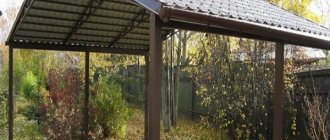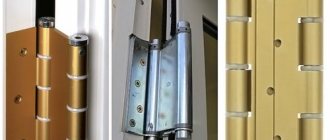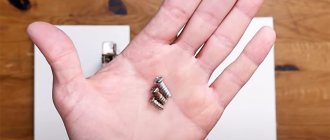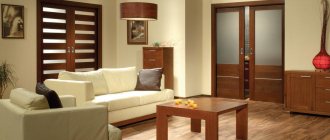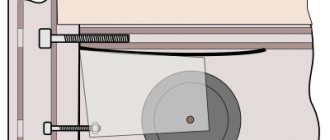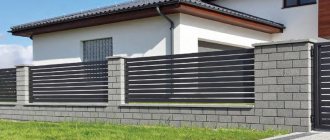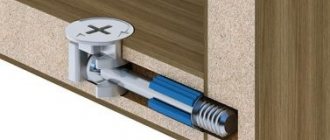General information
Door hinges are an elementary mechanism by which the door leaf is attached to the frame. Currently, canopies are classified according to installation location, material, and design. Typically, knowledge of the design differences between door hinges is not required. Often, awnings come complete with a door. But if you ordered to make a door leaf and, in fact, a frame, then there is a high probability that you will have to choose the awnings yourself. This is where the theoretical experience gained from this article comes in handy. It is necessary to understand that all doors are equipped with two hinges. Although this only applies to those cases where the load on the canopy will not exceed 25 kilograms. Heavier doors require the installation of more massive canopies, usually 2-3 pieces.
Installation location
There are these types of door hinges depending on the installation location:
- for interior doors;
- for input.
Entrance doors should be stronger and heavier than interior doors. Therefore, massive dimensional hinges should be used that will support the weight of the structure. In addition, they are equipped with a special mechanism that prevents the door from lifting. Protrusions and depressions are made on the wings of the loops. When closed, they align with the box and the wings do not rise.
External hinges
Overhead canopies, also known as external ones, are rightfully considered the most ancient and popular. They appeared immediately after people mastered such a process as metal forging. Of course, there was no need to talk about any patterns or other subtleties, but such loops coped with their main purpose “excellently.” The first options were large enough, so they held massive doors without any problems. This is currently the cheapest type of awning and is mostly popular in rural areas. However, forged hinges are coming back into trend. This is due not only to the large selection of sizes, but also to the difference in patterns. Modern blacksmiths have done their best, so the variety of forms of such canopies is countless. Their key advantage is ease of installation. It is not necessary to pre-prepare the door frame. It is enough to screw the hinges to the leaf, and you can install the door in the designed position.
Internal hinges
Mortise hinges are, by and large, the same canopies, but with minor design features. That is why they are commonly called card loops. Typically, consumers are offered a huge number of different models, but all the differences lie in the shape of the decorative plug.
Some hinges of this type include bearings in their design. When properly lubricated, the door opens and closes very easily. But you need to understand that the bearing has its own resource and does not tolerate strong shocks and prolonged vibration. The cheapest options for door hinges do not have a special zinc (anti-corrosion) coating, so they fail quite quickly. Their key advantage over other types of hinges is that they are universal. Therefore, you can forget about searching for right or left loops.
Universal door hinge
It would seem that universal loops stand out against the background of any other type. Nevertheless, in some ways they are good, but in some respects they lag behind. Their main advantage is that they are double-sided. Therefore, they can be installed on doors opening both to the right and to the left. However, they are used quite rarely. This is due to the fact that for the most part they are not removable, and installing them on the door block is quite difficult. They need to be adjusted as precisely as possible, and only then can you count on the door looking good.
Often, a universal door hinge is used for mezzanines, cupboards, and swing doors. But even here they are not always used. The strength of such hinges is that they are made of galvanized steel, so during operation they practically do not wear out and are not subject to corrosive processes.
Overhead detachable hinges
This type of loops is practically no different from the type described above. However, this is the preferred option in many cases. This is due to the collapsible design. This solution allows us to reduce the complexity of installation work.
This is one of the best budget options. Such hinges, like the previous ones, are very reliable and of high quality. However, to dismantle them you will need to remove screws or nails, which is a significant disadvantage. Currently, there are a huge number of standard sizes of detachable hinges. Therefore, if you are planning to install the door leaf yourself, use just such canopies. It is much easier to work with them than with one-piece ones; they are not inferior in reliability and durability.
Existing types of door hinges
It is worth noting that purchasing hinges for internal doors is only necessary if the door leaf is made independently or if you purchase a kit without fittings. The matter is not simple and requires a competent approach.
When choosing hinges, the main condition must be observed - the high quality of their models
There are different types of hinges for interior doors, but, as a rule, they are selected according to:
- Material;
- Installation method;
- Constructions;
- Features of the mechanism;
- Mounting location.
Due to the fact that there are hinges on both entrance doors and interior doors, which differ from each other, you need to choose different fasteners. For example, for the entrance door, hinges are used, the purpose of which is for heavy structures. In addition, they have a unique mechanism through which it is completely impossible to remove the door from its hinges even with great desire and mechanical influence. Simpler structures are installed on interior doors, which are easy to install and, moreover, they are not able to withstand large-sized metal panels.
Briefly about screw-in hinges
Hinges consisting of two parts and having small threaded pins on each are called screw-in. The leaf part of the canopy is screwed into the door leaf, and the frame part is screwed into the door frame. They are often used on doors with overhang, but sometimes they are also used without overhang.
Models of screw-in hinges differ in the number of screw-in pins. For lightweight doors, two- and 3-pin options are used. For heavy doors, 4-pin hinges are used with the ability to adjust in 3 planes, which allows you to achieve maximum accuracy during installation. Repairing door hinges of this type is usually limited to replacing the pins. In cases of visible deformation or mechanical damage, it is easier to replace the loop with a new one.
To ensure silent operation, plastic inserts and metal balls are used, mounted in the body of the hinged part of the canopy. In general, installing this type of loops has several undeniable advantages. Firstly, it is reliability, and secondly, the possibility of using decorative caps.
Inserting hinges into interior doors
To make the awnings look beautiful, they can be embedded into wood - both the door frame and the door itself. Many people choose to do this work with their own hands, because there is nothing complicated about it. It will require several tools:
- Chisel;
- Hammer;
- Pencil;
Before you begin, it is important to correctly and accurately outline the canopy on all sides. Next, using these measurements, you need to make a recess with a depth equal to the thickness of the hinge material.
The whole process is clearly shown in the following video:
In order to make the grooves efficiently and correctly, it is important to take your time and approach this matter responsibly. It is necessary to make exactly the depth that will ideally correspond to the thickness of the plate. After all, if the groove is deeper, the frame protrusions will catch and opening and closing will not be smooth. And vice versa - if it’s too small, then there’s simply no room left for loops.
So, having more complete knowledge in the matter of choosing loops, you can make your choice more confidently. It is worth remembering that no matter the quality of the hinges, timely lubrication of the rotation elements will only extend their service life. Moreover, installing and inserting canopies will serve as a good experience and will be useful in the future.
They are sold ready-made, but you can order your own version. Another option is to purchase all the door parts and assemble it yourself. But in this case, you will need to install door hinges. Doing this work with your own hands is not at all difficult. The main thing is to follow the instructions. In addition to the installation technology, the article will discuss instructions for replacing door hinges and give useful tips.
DIY door locks and hinges
Repair and replacement of door hinges
You have become familiar with the technology of installing door hinges on a new door leaf. But what to do when door hinges need repairs? Basically, this work is carried out together with. Sometimes even this does not help and it is necessary to carry out work to replace the door hinges. Let's consider the step-by-step technology.
- We fix the door with wedges.
To open the hinge, we open the door. We fix the doors by placing wedges under them. When replacing door hinges, the doors themselves do not need to be removed. If wedges are installed, the doors rest on them and do not tip over. - Checking the sizes.
When replacing door hinges, you need to make sure that the new mechanisms are the correct size. Using a tape measure, we check the correct location of the loops. The hinges should be located at a distance of 20 cm from the bottom and top of the door frame. If this is not the case, you need to cut the loops into new places using the technology described above. - Remove the top loop.
We unscrew the screws that hold the hinge wing. We remove the wings from the door and pillar and check the quality of the wood. - We prepare the doors and pillars for screwing in new hinges.
If the wood under the hinges requires repairs, we clean it with sandpaper and apply a layer of stain or paint. - Installing a new loop.
We install a new door hinge into the existing recess. We attach the wings of the hinge to the door and the counter. To do this we use self-tapping screws and a screwdriver. After that we insert the axle into it. This completes the installation of the door hinge. - Repeat the steps for the bottom loop.
We unscrew the screws from the old bottom hinge and replace it. Replacing door hinges is completed by fixing the elements in their old place. The hinge wings are connected to the axle.
- We check that the hinges are installed correctly.
We remove the wedges from under the door, open and close it several times. If the door moves normally, the door hinge replacement has been completed successfully. All is ready!
What are door hinges made of?
Door hinges are an important part of any door. Their quality determines how well the doors will open and close in the future. Hinges are one of the most important parts of all doors, since the entire load of the door leaf falls on them. Only correctly installed hinges will ensure long and high-quality operation of the door. If you attach the hinges poorly, the door may not only close poorly, but may fall off after a few days.
Hinges are made from various materials: brass or steel. One of the most popular materials is brass, polished and similar to expensive metals. The disadvantage of this alloy is its softness. After some time, these loops may change shape. Door hinges made of brass are usually installed on interior doors.
Hinges are also made of zinc alloys. This option is much stronger than conventional hinges and, unlike brass, can withstand more weight. Steel hinges are installed.
Door hinge design
Door hinges are made not only from different materials, but also have different designs. According to the type of construction, they are divided into three types: screw-in, mortise and overhead. The first option is a structure of two wings that is attached to the frame, as well as to the door itself. It is important not to confuse the right and left hinges when purchasing. Before purchasing door hinges, we advise you to consult a specialist.
Mortise hinges. This option will perfectly protect against penetration into the apartment. This type of loop cannot be cut. They are made on the basis of bearings and have a long service life. Screw-in hinges. Installing these door hinges involves screwing them into the door itself. Such hinges should not be installed on doors made of low-quality wood, as the material may crack at the installation site. Previously, doors were installed on two hinges; now, in order to increase reliability, the door is installed on three hinges. The heaviest doors are installed on 4 or even more hinges.
When the door leaf is fixed, the horizontal and vertical levels are maintained, unscrew the middle screw from the top hinge card of the door frame. To securely fasten it to the wall, you need to screw in a longer screw. This trick should be repeated for the bottom door hinge. If the doorway in your house is lined with wooden beams, this action will ensure long and reliable operation of the door.
Some modern doors cannot be conquered using a regular chisel. To make loop notches, you may need a router. Then you need to cut the grooves with a chisel, making the necessary exit for the hinges. The next step is to drill holes and screw the hinges.
When installing door hinges, you need to remember that between the door frame and the door leaf there should be a gap of 1 - 1.5 mm on both sides. This is done to ensure that changes in the geometry and dimensions of the door associated with changes in humidity and temperature do not in any way affect the normal functioning of the door.
If you did everything correctly, then the installation of the hinges is complete. Modern hinges are well adjustable, which allows you to control the correct operation of the door.
This completes the installation of door hinges. We hang the canvas and enjoy the new door.
Hidden door hinges
Often the turning part of the canopy or hinge is visible to the naked eye when the door is closed. So, for those who do not want at least some part of the structure to be visible, there are hidden hinges. They have a very complex design and, therefore, are not cheap. The hinges are equipped with three rotary axes, so they are universal. When the doors are closed, such canopies are visible, which is their key advantage. As for the disadvantages, hidden door hinges are very expensive. Usually you will have to pay about $50 for one piece. On a heavy door it is necessary to install about 3 such awnings.
So we figured out what hidden door hinges are. The price for them, as you can see, is very high. It is for this reason that such canopies make sense not to change, but to repair. For the most part, the repair consists of replacing one of the axles, as well as adding fresh grease. In some cases, when several axes are deformed, it makes sense to give the hinges to specialists.
About overhead loops
Relatively recently, overhead loops have appeared on sale. The principle of their design and operation is not much different from classic mortise canopies. But there are several key features that set these loops apart from other types. Firstly, they do not need to be embedded into the leaf and door frame. This is due to design features. When the hinges are closed, the door hinges have a gap between the door leaf and the frame of no more than 3 mm. In this case, the canvas fastening card is included in the box fastening card.
The main disadvantage of such awnings is that they are undesirable for heavy doors. This is due to possible deformations and misalignment. But door hinges have a design that allows installation as quickly and simply as possible. This is an excellent solution for interior doors that are light in weight. They are usually not repaired, since the price allows for immediate replacement. If you are installing overhead hinges on heavy doors, then do not install less than 3 hinges. The distance between each should be the same, but not less than 30 centimeters.
Design features of mortise and overlay elements
According to regulatory documentation, overhead and mortise products do not differ from each other. This can be seen in numerous drawings. They show that the structural elements are the same. They are ordinary card hinges that are attached to the door frame. The only difference between them is the method of preparation:
- overhead loops do not require preparation;
- Before installing mortise models, you need to make a small recess in the box so that they fit into it.
Overlay elements have been used since ancient times.
They could only be made by skilled craftsmen who made a real work of art from a piece of iron. Moreover, these products did not differ in particular symmetry. Current types of door hinges are produced smooth and made to fit a specific frame. In ancient times, blacksmiths made them in large sizes and not always of the same shape.
However, such elements are used by many designers who create antique interiors in country houses. Most users note the ease of installation. The hinges are easily screwed on and the doors are installed in the required position.
Today, types of overhead-type interior door hinges are widely used. The most common was the invoice, or “butterfly”. This type can be folded to a very small thickness, reminiscent of butterfly wings. This is an important advantage, since there is no need to do additional work with the door frame.
Mortise products are no different in design from the previous type. The only difference is the installation method. Before installation, you need to make holes in the box and put hinges in them. Fastening is done using screws. They can be either detachable or universal. The latter are more rigid and can withstand structures with greater weight. In addition, they prevent sagging.
Another difference is the presence of different mechanisms in detachable hinges. They are left-handed and right-handed. And universal types are installed regardless of direction.

